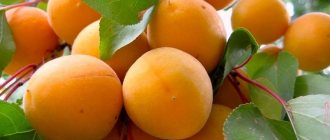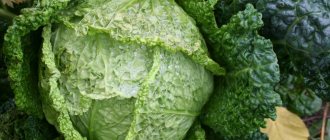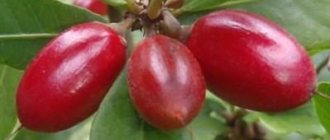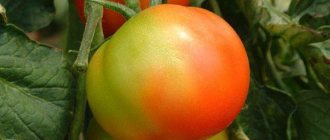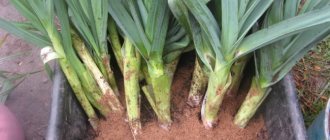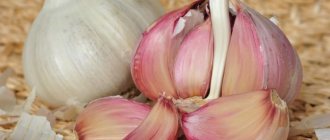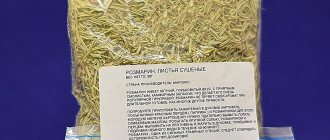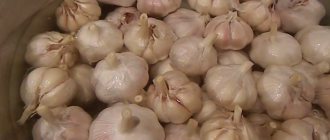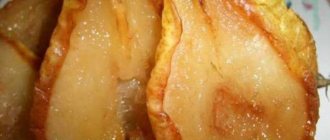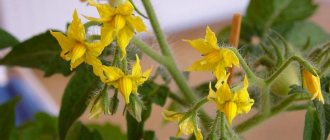How to propagate apricot: basic growing methods
A neighbor told me how to propagate apricots from cuttings at home. The apricot tree interested me because of its ease of care and the taste of aromatic fruits. In addition, the plant adapts perfectly to the vagaries of nature. And after 6 years I was feasting on delicious fruits.
The benefits of propagating apricots with your own hands
Methods for propagating apricot by cuttings
Stages:
- A cutting with several leaves is cut from the middle of the shoot in the morning.
- The shoots are planted in a pre-fertilized area and watered regularly. After a month, the cuttings develop a strong root system
The shoot is immersed in a special solution (Zircon, Kornevin) for 10-15 hours.
Rules and terms for selecting cuttings
Stages:
- Autumn harvesting of apricot cuttings is carried out with the onset of the first serious frosts.
- One-year-old shoots are selected for grafting.
- The cutting must be in the dormant stage
Landing Features
| diz-cafe.com ” src=”https://qlumba.com/wp-content/uploads/2019/10/fmg5db1358ca1e0f8.jpg” alt=”table_pic_” w /> | Lignified cuttings Stages:
|
| fermer.blog ” src=”https://qlumba.com/wp-content/uploads/2019/10/fmg5db13590b00f12.jpg” alt=”table_pic_” w /> | Air layering Stages:
|
| nagrunte.ru ” src=”https://qlumba.com/wp-content/uploads/2019/10/fmg5db13596af8dc0.jpg” alt=”table_pic_” w /> | In winter - early spring Stages:
|
| dacha.help ” src=”https://qlumba.com/wp-content/uploads/2019/10/fmg5db1359dae6202.jpg” alt=”table_pic_” w /> | In summer Stages:
|
| sad-sib.ru ” src=”https://qlumba.com/wp-content/uploads/2019/10/fmg5db135a36eebc0.jpg” alt=”table_pic_” w /> | Rules for preparing cuttings for planting |
Stages:
- A cutting with 2-3 internodes is treated with a special solution (Heteroauxin or Kornevin).
- The cuttings are kept indoors at a temperature of +24 degrees for 16 hours.
- Before planting in the ground, they are washed in water.
Rules for caring for apricots during different periods of the growing season
Stages:
- In early spring, sanitary pruning of apricots is carried out.
- The trunk of trees and the beginning of the main branches are whitened with lime.
- The first fertilizer can be a solution of urea, saltpeter, or chicken droppings.
- To control pests, the tree is treated with Agravertin and Akarin.
Growing from seed
Propagating apricots can seem like a daunting task for a novice gardener. The easiest way is to use a bone. The main advantage of the method is the ability of planting material to grow and bear fruit in the climatic conditions in which its parent was kept. The gardener should:
- prepare seeds;
- take care of their stratification;
- know the peculiarities of planting seeds.
For propagation, the best seeds are those of apricots that are grown in neighboring areas or in this region. But, if it is difficult to get them, then you can experiment with any varieties of apricot. The main thing is that they are grown in climatic conditions close to the place of cultivation. Seed stratification is the basis of crop propagation. The ability of a plant to survive under the scorching summer sun and winter cold depends on the quality of stratification. This process helps to establish the necessary qualities of seeds in a climate favorable to them.
Before planting, the seeds should be germinated
How can you propagate apricot with green cuttings at home, planting methods
The apricot tree attracts the attention of gardeners due to its ease of care, resistance to environmental changes, high yield and taste of ripe fruits, which are popular both fresh and processed. How to properly propagate apricots in your own garden, and how to care for established cuttings? Let's deal with everything in order.
Reproduction methods
Apricot trees can be propagated in three ways: by pitting, cuttings or grafting. However, for any of them it is necessary to adhere to some recommendations and follow an algorithm that simplifies the process as much as possible.
Growing from seed
This method is considered time-consuming, but the most reliable. Growing from the seed of a local tree guarantees high adaptation of the future apricot to the climate conditions of a particular region.
First of all, you need to choose a suitable material for planting - a ripe fruit seed. The apricot kernel retains all its maternal properties, so you need to choose the largest and juiciest fruit, making sure that the tree does not suffer from diseases characteristic of garden crops.
It is best to take several seedlings in order to subsequently select the strongest ones, since apricot trees are not famous for their high survival rate.
The following is the standard landing algorithm:
- The bones are soaked for a day in warm running water. Floating seedlings are considered bad and are rejected.
- Landing in progress:
- in autumn (September-early October). With the onset of November, there is a possibility that the seedlings will be stolen by rodents. Therefore, it is better to postpone late sowing and wait until spring;
- spring (early April). Apricot kernels collected in the fall overwinter in a cool, dark place until March. Spring planting is good because it allows you to harden the seeds. The process is called stratification and is carried out by soaking them in cool water for 5-7 days. At the same time, the water is periodically renewed in order to prevent it from warming to room temperature.
- The apricot pit is placed in a prepared hole (up to 10 centimeters deep) and sprinkled with humus.
- Sufficient care rules include regular watering, loosening the soil, and mulching with peat.
- Formed apricot trees are transplanted to a permanent place in the fall, at the age of 2 years. Thus, the seedlings will be able to overwinter and produce good growth in the spring. After another couple of years, the first harvest appears.
Apricot propagation by cuttings
Like all plants, over time the apricot ages and loses its ability to bear fruit. Is it possible to grow a new apricot tree of the same species as the old one if it is not possible to obtain seedling material from its fruit? There is such a method, and it is called cuttings.
It can be done in several ways:
- Green shoots. To successfully propagate an apricot, part of the branch with leaves is separated from the middle part of the shoot. An ideal cutting should have three leaves and be cut in the morning so that the branches are saturated with moisture. After cutting, the green shoots are dipped for 10-15 hours in a solution that stimulates the growth of the root system (Kornevin, Heteroauxin, Zircon).
We figured out how to propagate apricots, but how to grow them? For germination, finished cuttings are planted in open ground, where fertilizers are applied and soil moisture is maintained. Such conditions allow callus to appear as early as 10-15 days, and after another month you can see a healthy root system.
- Lignified cuttings. To grow a healthy apricot propagated in this way, it is necessary to harvest cuttings during the dormant period (after leaf fall and before early spring). The average length of planting material is 30 centimeters. Shoots cut in autumn are stored in a cool place until spring, when they are planted in a box or open ground saturated with peat.
- Air layering. This method of vegetative propagation is effective, but undeservedly forgotten by modern gardeners. In summer, a branch is selected with an annual growth that is significantly different from earlier sections of the plant. Make 2 circular cuts on it, removing the bark between them. The damage is treated with a growth-stimulating solution and wrapped in a plastic bag so that there is room for soil. In this way, you can grow cuttings, which, when ripe, are separated from the branch and planted separately.
Reproduction by grafting
This method is most preferred by gardeners, as it allows you to experiment by crossing varieties. As a rootstock for grafting, seedlings of not only apricot, but also almond, peach, plum, and mirabelle are used. However, good compatibility does not always happen. Through trial and error, you will have to select a rootstock that is suitable for the climatic conditions and taste preferences of the gardener.
The preparation for grafting is done in the fall. A strong, healthy, one-year-old shoot is selected as a cutting, and its upper part is cut off with an oblique cut. The shoots are stored in the refrigerator or a bucket of cool water until the scion.
The vaccination is done in the spring, at the beginning of May. This time is considered successful due to the active movement of juices throughout the plant, which improves fusion. The cutting is attached to the scion, on which the same vertical oblique cut is made. The cuts should be beveled at the same angle and have the same diameter. The joint seam is coated with garden varnish and secured with electrical tape.
The cuttings quickly take root on the new plant; within a month you can notice the appearance of new leaves.
Helpful advice: before the growing season, the grafted rootstock is cut back by 1-2 centimeters. Such actions will help the apricot to correctly distribute forces between old and newly acquired shoots.
How to care for an established cutting?
Self-grown apricot tree seedlings adapt perfectly to growing conditions. Care comes down to the following points:
- Crown formation. The tree grows upward and is not able to form on its own. Side branches are pruned annually to maintain the quality and duration of the yield.
- Soil selection. The best soil for planting apricot seeds is loamy or slightly loamy. The only condition is that the soil must have high drainage properties and be sprinkled with humus on top.
- Feeding. It comes in two types:
- root (fertilizer is applied to special circles around the trunk). Root fertilizers are applied before and after flowering. Nitrogen-containing substances and organic fertilizers sold in specialized stores are excellent for this. Before the wintering period, the soil is saturated with potassium and phosphorus;
- foliar (liquid fertilizers are sprayed on stems and leaves). Mainly used in summer. The crown is sprayed with complex fertilizer solutions.
- Abundant watering. Trees are watered in the tree trunk circle 4 times a year - during flowering, fruit ripening, hardening of seeds and before the hibernation period.
- Protection of sprouts from mechanical damage and pests. To do this, the young plant is covered with a two-liter plastic bottle with the bottom or neck cut off.
Recommendations
Shoots selected for propagation must be intact, with healthy bark, and without signs of disease. All instruments should be treated with a disinfectant solution before use. The room where the workpieces are stored must be at an optimal temperature. The appearance of rot, blackening of shoots, absence of roots or damage to them are reasons for removing planting material.
Regardless of the chosen apricot propagation method, the tree needs care.
Basic principles:
- crown formation (annual pruning of side branches);
- feeding (apply organic preparations under the roots before and after flowering, feed with potassium and phosphorus before wintering);
- watering at least 4 times a year: in the spring, during the formation of the bud, during the ripening of the fruits, before the tree goes into hibernation.
Depending on the varietal characteristics, the tree should be treated preventively against diseases and pests.
Apricot from cuttings
Today, basically all fruit trees can be propagated by grafting. This method allows you to obtain a plant identical to the original one. Also, by grafting, you can select the best qualities of a crop: increase immunity to diseases, increase frost resistance and much more. Apricot propagation can be done in several ways, the most proven and popular of which is cuttings. In this article we will tell you what types of grafting there are, how to propagate apricots using green cuttings and how to graft the plant correctly.
The benefits of growing apricots with your own hands
It happens that a neighbor will treat you with a surplus of delicious fruits, but he himself doesn’t even really remember the type of plant or doesn’t know it, since he got it from the previous owners of the garden. In this case, the only solution is to propagate the tree in the most suitable and reliable way. You can grow a young seedling for free, and its characteristics will be known in advance.
Another advantage of self-propagation of apricots is that the chances of running into unscrupulous sellers and purchasing low-quality planting material are reduced to zero. The gardener himself controls the entire process and has the opportunity to obtain the number of plants he needs while minimizing costs .
How can you propagate apricot with green cuttings at home, planting methods
Preparation of planting material
For a successful result, you need to choose the right planting material:
- The pits from apricots that grow in the area are best suited for propagation.
- When it is not possible to find seeds from zoned crops, they can be ordered by mail from gardeners living in areas with a similar climate, for example, in Siberia or the Far Eastern region. The apricots growing there have high endurance, so they will feel great anywhere.
- If you can’t get seeds at all, you can also use fruits sold on the market. You should not buy imported varieties; you won’t be able to grow a good apricot from them.
For planting, choose the best fruits, slightly overripe, the pulp should be easily separated from the stone. It is good if there are a lot of seeds, because some will lose their germination after pre-sowing treatment. The largest seeds are selected, washed and dried in the shade.
Types of propagation methods
Apricot reproduces both by seeds and by vegetative methods. In certain cases, it is preferable to choose one method or another. If you decide to plant one apricot, it is better to purchase a seedling. If you need a tree that will exactly match the varietal quality of another, then you should not choose seeds for propagation.
It is better to use cuttings (propagation by shoots) and grafting (budding).
Planting apricot kernels can result in a tree with undesirable characteristics.
Stratification
If you immediately plant the seed in the ground, perhaps a sprout will appear, but the first frost will destroy the plant. Therefore, for a successful result, the seed material needs to be prepared and stratified:
- The seeds are mixed with coarse sand in a ratio of 1:3. If peat is used, take 2 parts.
- The mixture is laid out in boxes with a wall height of no more than 60 cm to ensure oxygen access to the lower layers. Store in a cool place at a temperature no higher than 2–8 degrees.
- The composition must be stirred periodically, since the seeds actively “breathe” and if there is not enough air, they begin to rot.
- To prevent drying out, the sand is moistened, but not too much so that the seeds do not become damp.
- In this state, the seed is stored for 100 days, then it can be planted in the soil.
If stratification was not carried out in advance, you can use the emergency method. The seeds are filled with snow water for 10 days, changing it daily. Place it in a regular freezer several times overnight. This treatment will help identify the most resilient plants.
Growing from seed
Propagating apricots can seem like a daunting task for a novice gardener. The easiest way is to use a bone. The main advantage of the method is the ability of planting material to grow and bear fruit in the climatic conditions in which its parent was kept. The gardener should:
- prepare seeds;
- take care of their stratification;
- know the peculiarities of planting seeds.
Crown formation
The formation of the apricot crown must begin after a year of planting. The fact is that the tree grows rapidly upward, and at the same time the crown does not form on its own. That is why it is necessary to tie the middle branches down to form the top.
Pruning an adult apricot
Otherwise, if there is an insufficient number of lateral branches, the apricot will not bear fruit fully. You cannot trim the middle branches, as this will weaken the tree.
It must be remembered that apricots do not have yield rationing, like other fruit trees. Because of this, you need to independently control the number of branches. In an adult tree, the side branches need to be periodically cut off to preserve high-quality fruit and a long harvest.
When to graft an apricot: in spring or autumn
The result depends on the time of vaccination. The correct period guarantees the longevity of the scion and a bountiful harvest.
Carrying out the procedure at different times has its own characteristics and depends on the vegetation characteristics of the plant.
The ideal period is before the start of sap flow, but when the tree begins to wake up. Usually this is early spring. The exact timing of vaccinations depends on climatic conditions. They may differ from the first ten days of March in the southern regions and until the last days of April in the more northern regions.
You can understand that the best time for vaccination has come based on the following conditions:
- The threat of frost has passed;
- The average temperature during the day is not lower than 6-8 degrees, and at night not lower than zero;
- The buds have already begun to swell.
You can also follow the popular saying: the ground should thaw two shovels deep. Then it’s time to plant stone fruits.
Sometimes grafting is possible during the summer. It occurs during the second period of sap flow, that is, after harvesting: from the end of July to the end of August. You can determine the right time by the well-separated bark from the trunk. In summer, green cuttings are grafted.
It is not recommended to vaccinate in the autumn months, except in the southern regions. The cuttings will not have time to take root and adapt. The tree needs strength to grow. In central regions, autumn vaccination cannot be done for two reasons:
- In autumn, the plant devotes all its energy to preparing for winter. Therefore, any operations can shorten his life.
- The grafted branch may freeze in winter, and all efforts will be in vain.
Vaccination is a real operation, so the procedure is taken as seriously as possible.
Reproduction methods and technology
If you need to breed the apricot you like, you should familiarize yourself with all the common methods in advance and choose the most reliable and suitable one. After all, each of them has its own pros and cons.
Cuttings and layering
Propagation by cuttings or strokes is the fastest, most reliable, but at the same time labor-intensive method. The main problem is to prepare the material correctly and on time.
Green cuttings
To propagate by green cuttings, you will need to separate part of the shoot with leaves from the middle part. The cut branch must have at least three leaves. The preparation is done in the morning so that the shoot is as saturated with moisture as possible. After this, the cuttings are placed in a solution of a root formation stimulator (for example, “Zircon” or “Kornevin”) for 12 hours.
After this procedure, the workpieces are sent to a well-filled bed with fertilizers and a small greenhouse is organized. You can do without it, but in this case you need to constantly monitor the level of humidity and prevent the soil from drying out. After a couple of weeks, callus begins to form, and after a month the seedling already has a root system.
Lignified cuttings
Cuttings are carried out not only from green shoots, but also from lignified shoots. Harvesting is done during the dormant period, when leaf fall has ended. The length of the cuttings should be about 0.3 m. They are stored in a dark, cool place until spring, and then soaked in a root formation stimulator and planted in soil fertilized with peat.
Air layering
No less effective way of propagating apricots than cuttings, although undeservedly forgotten by gardeners. In summer, it is necessary to select a shoot with annual growth. Make two cuts in a circle on it and remove the bark between them. This place is treated with a root formation stimulator and wrapped in a plastic bag so that soil can also be placed there. As soon as the cuttings mature, they are separated from the mother branch and planted in a permanent place of growth.
What can an apricot be grafted onto?
The grafting is carried out on a tree whose age has reached 3-5 years, and the thickness of the trunk is in the range of 3-10 cm. On more mature trees, the cutting takes root less well, and the operation will require certain skill and experience from the gardener. The procedure is not carried out with sick or poorly growing trees - you need to wait for their recovery and activation of growth, or abandon the idea altogether.
One-year-old apricots are grafted at a distance of 5-20 cm from the ground, and 2-3 year-old apricots are grafted onto skeletal branches. In the latter case, the distance from the standard should be minimal (20-50 cm). It is advisable to choose a vertical branch or one that tends upward - such shoots grow stronger than others and the chance of survival is higher.
The ideal “platform” for grafting an apricot is another apricot. Particularly good results are achieved by wild game, which has better resistance to frost and drought and is less likely to be damaged by pests and diseases.
In general, apricot can be grafted onto any stone fruit crop. The most optimal among them:
- Cherry plum. This option is gaining increasing popularity, since the species is a strong and fertile rootstock for numerous stone fruit crops. The cutting will take root quickly enough, and its fruits will become sweeter.
- Plum. The question of whether apricot can be grafted onto this crop has a positive answer. Semi-wild varieties of rootstock are often selected, since the apricot cuttings located on them acquire positive qualities. High compatibility is proven by minimal growth at the joint.
- Turn. Gardeners quite often practice this procedure, but you should choose wild rootstock or “damson”. Sloe grafting promises the appearance of a large number of shoots. To reduce it, the articulation is performed as low as possible, not far from the root collar of the rootstock.
- Cherry. This option is possible, but the probability of failure is higher. for the task , because the main difficulty lies in the fragility of its branches. With further growth of the scion, the installation of supports will be required. Preliminary grafting of cherry plums or plums onto cherries can increase the chance of success. The result is a special graft, popularly called an “insert”.
- Peach. A very good “companion” for apricot, however, the grafting is successfully implemented only in the southern regions. The culture is not resistant to severe frosts and in the northern regions the cuttings may freeze. At the same time, the apricot itself will be the answer to what the peach can be grafted onto. The list of compatible trees also includes cherry plum, wild almond, plum, felt cherry, and sloe.
Rules for caring for established apricots
Apricot will take root only if the rules of planting and care are followed. Among them are:
- correct choice of landing site;
- suitable soil;
- regular watering;
- fertilizer, etc.
The most advantageous place for planting is a well-lit area that receives direct sunlight. The place must be protected from strong gusts of wind.
For planting apricots, areas with light sandy and sandy loam soil are usually selected. It can contain peat and other inclusions. For the first few weeks after planting, an unrooted tree should be watered once a week and the soil should be loosened so that air and water reach the root system.
Once every 2-3 years, for a better harvest, you need to fertilize the tree with special substances, which are sold in every specialized store.
Purpose of apricot grafting
Grafting allows you to improve the varietal qualities of a tree by placing one or more branches from another plant on it. The rootstock is the tree onto which the grafting is performed. It often has disease resistance and other advantages, but produces a low-quality harvest. A scion is a cutting from a varietal tree that is grafted.
Since apricot is a heat-loving crop, the main purpose of grafting is to improve winter hardiness. The procedure is especially relevant for northern regions with harsh climates. Other reasons include:
- cultivation of wild apricot;
- replacing an unsuccessfully chosen type of tree without removing it;
- the area of the site is limited and there is a desire to get several varieties on one tree;
- acceleration of fruiting;
- saving a dying tree by transferring cuttings to another plant;
- propagation of the variety you like.
Popular apricot varieties
Many apricot varieties of Russian and Ukrainian selection are suitable for growing in the middle zone. In addition to resistance to cold and pests, they have high yields.
Apricot Hargrand gives a bountiful harvest
How to prepare cuttings for grafting
The process of preparing cuttings for spring begins in the fall, immediately after the sap stops moving and the leaves fall off. If you postpone this process until winter, the cuttings most likely will not take root or will become weakened.
When selecting, give preference to strong cuttings, which are approximately five millimeters in diameter. Also, the indispensable attributes of the seedling should be several buds on the side and one on top - growth buds.
How to preserve cuttings until spring? You can place them in sawdust, moistened sand, or store them at low temperatures above zero. It is recommended to periodically wet the litter with water. This method allows you to preserve the cuttings in their original form.
